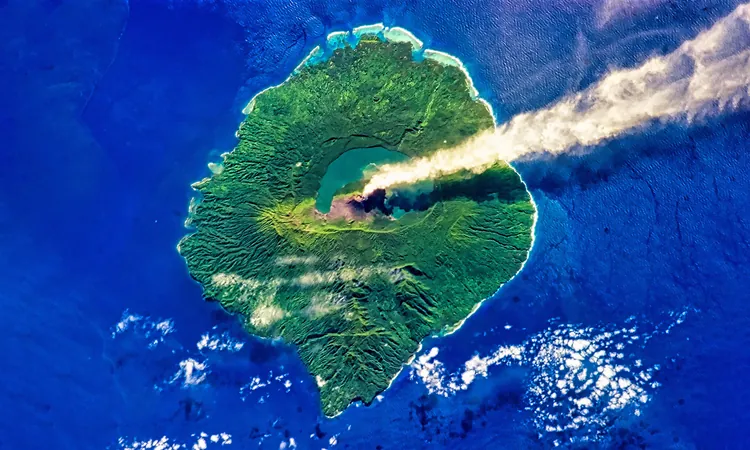
Can Plants Hold the Key to Predicting Volcanic Eruptions?
2025-01-05
Author: Ken Lee
Volcanoes are as magnificent as they are fearsome, yet much of the volcanic activity that precedes an eruption remains hidden beneath the Earth's surface. Traditional strategies to monitor these colossal forces of nature often concentrate on seismic readings and gas emissions. However, these techniques can overlook subtle indications of impending eruptions that lie unseen in rugged landscapes.
In their pursuit of new detection methods, scientists have recently turned their attention to plant life, which might just provide crucial warnings as to when a volcano is gearing up for an explosive event.
Volcanic Gases and the Role of Plants
Volcanic eruptions often release gases like carbon dioxide, which are produced as magma ascends. However, pinpointing these gases can be challenging since they also emanate from everyday sources. For remote volcanoes with little to no monitoring infrastructure, researchers have devised innovative ways to detect minor changes that may herald an eruption.
For instance, Robert Bogue from McGill University led a study in the Yellowstone Caldera, focusing on the relationship between vegetation health and hydrothermal activity. His research highlighted how plants adapt to subterranean shifts, which might indicate rising magma and a potential eruption.
Plant Responses to Volcanic Indicators
Plants are not passive organisms; they actively respond to their surroundings. Changes in photosynthesis, leaf structure, and overall growth can signal variations in carbon dioxide levels, sulfur exposure, and soil temperature—all of which frequently occur in volcanic regions. Scientists theorize that such plant responses could reveal signals months or years before eruptions occur.
However, spotting these subtle changes can be daunting in sprawling forests where natural weather variations can obscure the signs. Hence, researchers have increasingly turned to satellite imaging, which allows for the survey of extensive areas and uncovers unusual patterns of plant health.
The Science Behind Monitoring Vegetation
One effective method employed is the Normalized Difference Vegetation Index (NDVI), which assesses plant photosynthesis efficiency by monitoring chlorophyll levels. Scores calculated through NDVI range from negative to 1, with higher scores indicating healthier foliage. By observing these values over time, researchers can discern trends that correlate with changes in the underlying geological activity.
In research focused on volcanic areas, initial bursts of gas can actually promote plant growth through added nutrients. Yet, if concentrations become too high or soil temperatures soar, plants can become stressed or die off.
Case Study: Tern Lake in Yellowstone
A prime example of this phenomenon is at Tern Lake within the Yellowstone Caldera. Between 1984 and 2022, analysis of Landsat imagery uncovered a trend of improved tree health in the area for about 16 years, presumably due to enriched soil nutrients. However, around the early 2000s, indicators such as infrared data revealed a downturn as extreme soil temperatures and toxic gases emerged, resulting in widespread die-off of lodgepole pines.
Further research suggested that these transformations were tied to paths of hydrothermal fluids becoming more active. Earthquake data lent credence to this interpretation, revealing that minor seismic tremors often stem from magma or hot fluids seeking new exit routes.
The Vanishing Act of Vegetation
Despite significant vegetation stress, observations indicated that some areas later exhibited new seedlings, suggesting a potential stabilization of conditions. Such patterns reinforce the idea that volcanic processes are dynamic and ever-changing, rather than linear.
Implications for Future Research and Volcano Monitoring
This groundbreaking research underscores the potential for forests to serve as vital early warning systems. While thermal cameras and gas detectors play important roles in assessing volcanic hazards, they are not always feasible in remote locations. Satellite imagery can assist in monitoring expansive regions without necessitating physical presence on-site.
The integration of plant observations with other geological signals—like minor tremors, land deformation, and shifts in gas composition—could prove to be instrumental in predicting eruptions more accurately.
Volcanoes are each unique, dictating that monitoring strategies must be adaptive. For regions suitable for lush plant growth, vegetation analysis may reveal vital clues regarding volcanic activity. But in arid areas or regions experiencing drought, this approach may fall short.
The unveiling of how plants can act as indicators adds yet another tool in the toolkit of volcanologists, ultimately optimizing efforts to monitor those volcanoes that pose the greatest risk. The findings from Tern Lake not only help pave the way for more effective monitoring but hold the promise of issuing eruption alerts with unprecedented timing in the future.
This revolutionary study was published in the journal Geochemistry, Geophysics, Geosystems.
Stay tuned for more fascinating insights into the intersection of nature, science, and safety!


 Brasil (PT)
Brasil (PT)
 Canada (EN)
Canada (EN)
 Chile (ES)
Chile (ES)
 Česko (CS)
Česko (CS)
 대한민국 (KO)
대한민국 (KO)
 España (ES)
España (ES)
 France (FR)
France (FR)
 Hong Kong (EN)
Hong Kong (EN)
 Italia (IT)
Italia (IT)
 日本 (JA)
日本 (JA)
 Magyarország (HU)
Magyarország (HU)
 Norge (NO)
Norge (NO)
 Polska (PL)
Polska (PL)
 Schweiz (DE)
Schweiz (DE)
 Singapore (EN)
Singapore (EN)
 Sverige (SV)
Sverige (SV)
 Suomi (FI)
Suomi (FI)
 Türkiye (TR)
Türkiye (TR)
 الإمارات العربية المتحدة (AR)
الإمارات العربية المتحدة (AR)